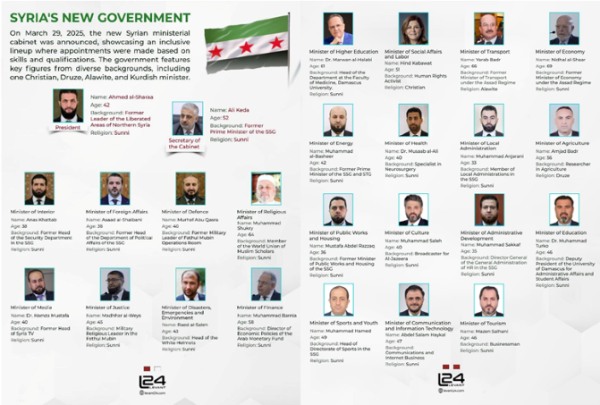President Ahmad al-Sharaa presents new cabinet; Inclusion of Kurdish, Alawite, Greek (Rûm) Orthodox, and Druze ministers buys him time and goodwill
DARAMSUQ — After 2 months in office after the ‘Victory Conference’, President Ahmad al-Sharaa of the Syrian Arab Republic yesterday announced his new equipe of ministers. His new Transitional Government is Sunni dominated with core ministries Defense, Foreign Affairs, and Interior going to confidants of ‘dissolved’ Hay’at Tahrir al-Sham.
Asaad al-Shaibani, a Mhallami (Mhalmoyo) from the Gozarto (Jazeera) Region, retains his position as Minister of Foreign Affairs, Murhaf Abu Qasra remains on Defense, Maddhar al-Weys holds on to the Justice Ministry, Muhammad Barnia gets the Finance Ministry, and Anas Khattab – currently head of the General Intelligence Directorate – will be Minister of the Interior. Mohammed al-Bashir gets the Energy portfolio after having headed the Transitional Government since December. The new ministers were sworn into the Transitional Government at a ceremony yesterday evening, some two weeks after Sharaa signed the draft Constitutional Declaration.
The new Transitional Government includes Hind Kabawat as Minister of Social Affairs and Labor. She is from Daramsuq (Damascus), Greek (Rûm) Orthodox, and the only woman in the Transitional Government. Muhammad Abdul Rahman Turko, a Kurd from occupied Afrin, becomes Minister of Education, the Alawite Yarab Badr will become Minister of Transport, and Amjad Badr, a Druze from Sweida will become Minister of Agriculture.
The ministers were appointed without consulting all components of the Syrian people or their political representatives. For example, there are no ministers from official parties represented in the Democratic Autonomous Administration of the Region of North and East Syria, even though the Region comprises a significant percentage of the Syrian population, economy and cultural diversity.
Not including Syriac political parties, such as the Syriac Union Party, which are the legitimate representatives and defenders of the rights of the Syriac people, is a major omission in securing and protecting the demands of the Syriac people, who have given the country its name Syria.
For now, the inclusion of a Kurd, Druze, Alawite, and Greek (Rûm) Orthodox woman buys Al-Sharaa (Western) time and goodwill. But for how long? The road to a truly inclusive Syria seems destined for federalism. All signs point in that direction. The inclusion of smaller components in a centrally-led government seems a distraction from the bigger question of how to move forward to a federal Syria, where Syriacs (Arameans-Assyrians-Chaldeans), Druze, Alawites, Kurds, Yezidis, Turkmen, and all other population groups that make up the Syrian mosaic, are given their full local and national political, linguistic, religious, and economic rights.





















